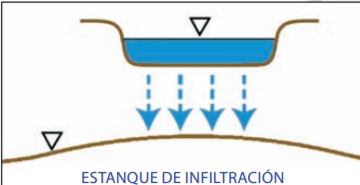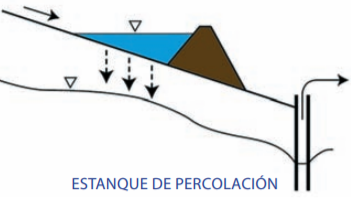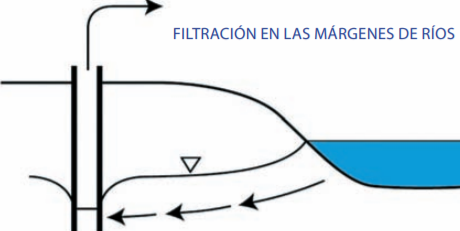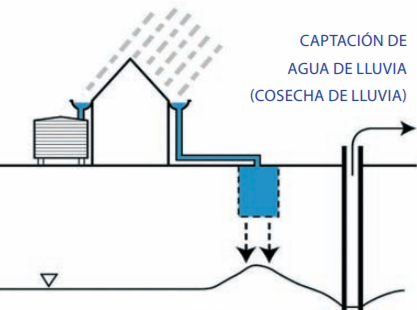Aquifer Recharge Improvement:
Aquifer recharge techniques have been widely applied to manage available resources. Methodologies vary in complexity, from simple rainwater harvesting to injection of recycled water into a brackish aquifer through deep wells. [1]
Watershed investment can help intercept precipitation, decrease surface water flow, and increase the potential for water to percolate past the ground surface and recharge underlying aquifers. However, it is important to consider factors such as annual precipitation, actual evapotranspiration, vegetation cover, soil texture and slope together represent the potential for activities to impact the infiltration potential of an area. Thus, it is important to identify the recharge areas of an aquifer and the land covers present, since a large proportion of groundwater recharge can occur when water precipitates or flows over aquifers. Therefore, activities to enhance recharge are most effective if they are carried out in areas where there is a high potential for recharge based on an assessment of the underlying geology.
Generally low levels of technology are required,, where water catchments are used to increase recharge, the construction of embankments, and small dams through ephemeral streams. It is common to dig wells and divert surface flow into wells (despite potential contamination problems).
The methodologies used are broadly grouped into the following categories:
Distribution methods Water distribution methods are applied when the free or semi-confined aquifer to be recharged is close  to the soil surface. Recharge is achieved by infiltration through the permeable surface material, which must be managed to maintain infiltration rates. An infiltration pond can be used which is dug into the ground, or comprises a depressed area of land, which retains the recharge water (e.g. rainwater), until it has infiltrated through the soil.
to the soil surface. Recharge is achieved by infiltration through the permeable surface material, which must be managed to maintain infiltration rates. An infiltration pond can be used which is dug into the ground, or comprises a depressed area of land, which retains the recharge water (e.g. rainwater), until it has infiltrated through the soil.
Similarly, the Soil-Aquifer Treatment (Soil-Aquifer Treatment) (SAT) technique is based on the use of water from water treatment plants (WTP), where the reuse of water is planned through infiltration ponds where the water is treated at the secondary and chlorinated level.
Modifications inside the canal: by constructing check dams in the watercourses, the construction material being the river alluvium itself. These structures simply slow the flow of water into the course allowing the water to infiltrate into the soil while reducing soil erosion..
itself. These structures simply slow the flow of water into the course allowing the water to infiltrate into the soil while reducing soil erosion..
Wells, tunnels and boreholes used in areas where the surface layers have low permeability, and therefore the distribution methods are not effective. The use of wells that have dried up because the water table decreased due to overexploitation is carried out. Boreholes can also be drilled if there are thick and low-permeability strata exist above the target aquifers.
Clogging of aquifer or borehole filter material, either by suspended sediment, air entering the recharge water, microbial growth or chemical precipitation, is a common problem, causing excessive rise in water levels in the recharge well. These clogging processes can be managed by mechanical treatment of the recharge water allowing sedimentation or previous filtering in order to remove suspended solids.
Induced infiltration on riverbanks, commonly in a gallery or a line of boreholes parallel to the margin  of a body of surface water and at a short distance from it, inducing the water of the stream to enter the aquifer system.
of a body of surface water and at a short distance from it, inducing the water of the stream to enter the aquifer system.
The factors that determine the success of induced infiltration projects are the availability of a reliable source of surface water of acceptable quality, and the permeability of the river or lake bed deposits.
Rainwater harvesting refers to the collection of runoff for productive use. It includes the collection of rainwater from roofs for direct consumption or for groundwater recharge by connecting the outlet pipe of the roof drain to divert rainwater to pre-existing wells or other recharge structures.
consumption or for groundwater recharge by connecting the outlet pipe of the roof drain to divert rainwater to pre-existing wells or other recharge structures.
Soil cover: Vegetation and land use can have profound effects on aquifer recharge processes. Vegetation types and densities influence the evapotranspiration patterns and therefore the water available for recharge [2].
Bibliography
Sistema de Optimización de Inversión de Recursos. Introducción y Documentación Teórica. 2015. Natural Capital Project, et al.. | http://data.naturalcapitalproject.org/rios_releases/RIOSGuide_Combined_07May2015.pdf
[1] Estrategias para la Gestión de Recarga de Acuíferos (GRA) en Zonas Semiáridas. 2005. UNESCO. | https://cutt.ly/pEu1QMt
[2] Influencia del Tipo de Cobertura en Procesos de Recarga de Acuíferos. 2021. Gidahatari - consultoria. | https://gidahatari.com/ih-es/influencia-del-tipo-de-cobertura-en-procesos-de-recarga-de-acuiferos
Referencies
Articulo sobre la recarga de acuiferos | https://sig.mapama.gob.es/Docs/PDFServiciosProd2/RECHID_Recarga.pdf